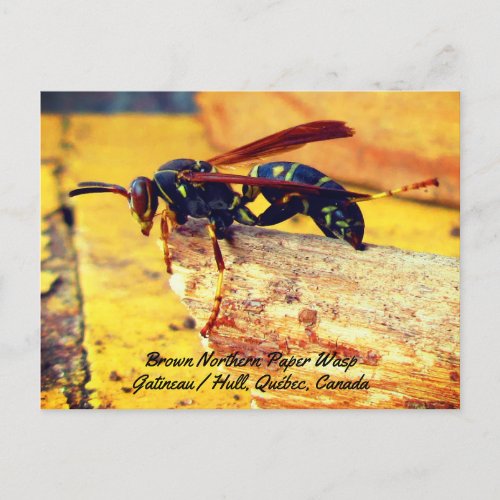Brown Black Yellow Northern Paper Wasp Grooming Postcard



This brown northern or golden paper wasp female is grooming her wings and abdomen after being rescued from drowning in a dish of water. She breathes through her abdomen using a system of tracheae or tubes, thus can suffocate if they're blocked, especially if her wings get wet and drag her under. She'll have to wait a few minutes to dry out, and she cleans herself prolifically. She's dark brown to black with brown wings and eyes, and yellow markings. In this profile view you can see one of her two beautiful brown spotted compound eyes. Like all wasps she also has three simple eyes on top of her head. Paper wasps are elegant creatures. They fly with back legs trailing and look like a little person - maybe that's where we got the idea of fairies! This is a great photo for anyone into natural science, bugs and insects, especially wasps; for nature and wildlife lovers, biologists, entomologists, bug collectors, anyone who studies or works with stinging insects on professional or amateur level. Paper wasps tend to build smaller nests of forty individuals at most - colonies I have seen so far have been 20 - 25 individuals. By comparison the yellowjacket and her relatives can form colonies of hundreds, even thousands of wasps! They all create their nests from masticated wood or plant fibers (such as bean leaves) in a location which is sheltered but takes full advantage of the sun. Without the warmth of the sun the wasps can't fly; they also use the sun to orient themselves on their flight paths. Generally, wasps are beneficial insects despite their fierce reputation. They eat insect pests such as flies, caterpillars and beetle larvae. They feed them to their own larvae - adult wasps cannot digest meat. Adult wasps get nourishment from drops of sweet fluid exuded by the larvae, nectar from flowers, blood or ichor from insect prey. In late summer all larvae have pupated and hatched, and the wasps range further afield looking for food. Any sugary liquid will do, including soft drinks, fruit juice and fruit drinks, hot dog relish, the blood or juices of burger meat. People often don't tolerate the presence of wasps due to the insects' ability to deliver one or more swift and powerful stings - however they are generally not aggressive unless you are destroying their house or trying to eat them (their perspective) by taking a bite of food the wasp has landed on. The normal reaction to wasp stings is swelling and intense burning pain in the area, lasting about a day depending on the species - apply ice to take down the swelling and relieve pain. Normally the sting is the last defensive mechanism a wasp will use. Males don't sting but tend to bluff and bluster a lot, making aggressive motions; they stop once they see you are not impressed. Both males, or drones, and female wasps have strong mandibles for tearing and chewing wood, and these can deliver a pinchy bite, but usually to other wasps, either subordinate relatives at the same nest, or yellowjackets, who seem to make a great game of teasing them. Female paper wasps are dominant in the nest, and males get bitten and bossed around a lot!


